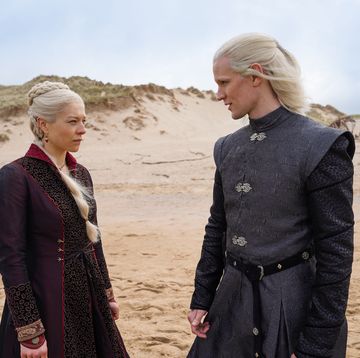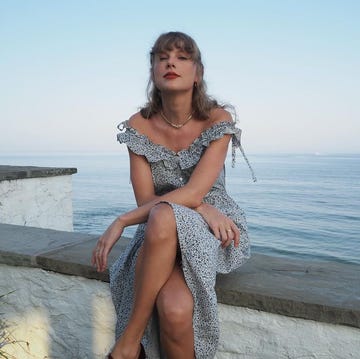In an art world landscape full of 'ones to watch', the historian and curator (and ELLE UK contributing editor) Aindrea Emelife is easily one of London's most talked about right now. Having first began making a name for herself through her Financial Times art column, which she began writing at 20 years old, she has gone on to curate an ever-growing list of shimmering, ambitious shows on both sides of the Atlantic that trace and centre the history of Black women. This year alone, she launched the exhibition 'Black Venus,' at Somerset House and 'Know Who We Are,' at Christie's. And next year, she'll curate Nigeria's pavilion at the 2024 Venus Biennale, a move that sealed Emelife's status as the year's breakout star.
She might be young but her success was a long time coming. As an eight-year-old Emelife would scribble down her impassioned ideas about the paintings she had seen at the National Portrait Gallery in London. It was the history of art that fascinated her and it led her to study at the Courtauld. ‘I’ll be honest, it was tough presenting my dream of being an art historian to my African parents, but a bursary and an unconditional offer to the best place to study was compelling’, she says with a smile.
Speaking with measure and confidence, today Emelife appears older than her 27 years. Her robust sense of self was formed early on. Reflecting on her time at the Courtauld she says, ‘As the only Black girl, I didn’t feel "other" as this was usual already for me from school. But it was expected that at university I would fall into African Art, despite it not being on the curriculum at the time. I resisted this as a lazy assumption, instead focussing on Surrealism, Modernism and Medieval Art. But I always found ways back to approach African Art surreptitiously – by expanding my essay assignments to include Nigerian Modernists.’ And in her spare time she admits she spent hours exploring Nigerian artists like Uche Okeke and Obiora Udechuckwu diving into rare books and journals like Nka.
Raised by her Nigerian mother, a project manager in the charity sector, in Southwest London, Emelife had no direct connection to the art world. She did however have a love of words and ideas from an early age. ‘Anyone who knows me knows I love a debate and that I am endlessly curious, perhaps, frustratingly so!’ She laughs. ‘I spend much of my time asking myself why, so it makes sense that I would want to be an art historian. Curiosity is part of the job. I get to ask questions and tell stories.’
By the age of 19, Emelife was already curating guerilla-style exhibitions at end-of-lease properties she would find around London. ‘I had big ideas early on.’ Things began to take off after she started writing an art column for the Financial Times in her second year at university. And she hasn’t looked back. This year, Emelife was announced as the curator of the Nigerian Pavilion at the 2024 Venice Biennale, a prestigious role. The exhibition will then tour to Nigeria. She was also appointed as the curator of The Museum of West African Art (MOWAA) in Benin City, a major museum site that will eventually see more than 300 objects, including the Benin Bronzes, returned to Nigeria for public display; the first section of the mammoth project is set to open next year.
2023 is proving to be an enthralling time to celebrate Nigerian art here in the UK. In recent months, the South London Gallery explored the connections between Lagos and Peckham, known as ‘Little Lagos’, in an exhibition of works by both British and British-Nigerian artists. In the summer, the young British-Nigerian artist Sola Olulode opened her first solo show, which unfolded like a storyboard in glowing golden-hued paintings about falling in love.
Meanwhile at Stephen Friedman Gallery in London, Yinka Shonibare – one of the UK’s leading contemporary artists, who has lived between Lagos and London throughout his life – presents a special exhibition inspired by nature featuring masks, quilts and sculptures (all important elements in his own works) by artists from Africa and its diaspora. Shonibare is also one of the artists Emelife has selected for her Nigerian Pavilion at Venice. The curator is enthused about 'the enormous range of talent and potential, as well as our historic legacy of creativity [from the region]. Lots of people know about the Benin Bronzes and the surge of exuberance in our contemporary art scene, but there is so much more...'
Since taking a post at MOWAA, Emelife now splits her time between London and Ikoyi, a bustling, affluent neighbourhood in Lagos where she shares an apartment with a friend. In Lagos, Emelife dresses differently ‘a lot of linen, more conservative, and I let my hair be wavy to avoid battling the humidity.’ She spends her days with her growing team taking studio visits with artists and on frequents trips to Benin City to visit the museum site, a hour-hour drive from Lagos. In the evenings, she unwinds in one of the city’s many restaurants ‘my favourites are SLoW, Nok by Alara, ITAN Test Kitchen or ONA... Being there makes sense – I feel more connected to the mission. In some ways I also feel at rest there, which is interesting because Lagos is anything but peaceful!’
Earlier this year, Emelife also opened the London iteration of her critically acclaimed touring show at Somerset House. The show includes works by legendary figures such as Lorna Simpson, Sonia Boyce and Carrie Mae Weems. 'It was tremendously exciting to work with some of the artists who made me want to get into the field,' Emelife says. 'It’s a show that’s been "in me" for so long; I'm proud to see all the responses it has had critically, but also from young Black women - that impact is probably the most fulfilling.' The show, she says, is part of her ongoing mission as a curator 'to expand the history of Black women', but is quick to point out that the five-room exhibition 'is not the full story'.
Whether it's retelling the story of Black women from her perspective or creating spaces for representing the breadth of Nigerian art, Emelife emphasizes the collaborative aspects of her job: engaging in a wide-range of voices, working with new writers, and listening to the artists is necessary when rewriting history. Especially if you're creating an image of a multicultural, vibrant Nigerian scene where the reality is a nation ‘made up of hundreds of languages and tribes, with almost 70% of the population under the age of 30 and an average age of 17'.
As part of Frieze London this year, Emelife has curated something close to her heart , an exhibition and auction at Christie’s where the exhibiting artists have donated works to benefit MOWAA. Artists such as Yinka Shonibare, Tunji Adeniyi-Hones and Kehinde Wiley (known for his portrait of Obama) feature in the sale. Emelife hopes the exhibit tells a universal story centred around artists from Africa and the African diaspora and ‘opening new doors so we can have a more expansive world view'.
It's ultimately this, she says, that is the motivation behind all of her projects as a curator. ‘I will always be inspired by narratives that have been overlooked. For me, it feels like a duty – as a Black person, as a woman, as an African, as a British person. There is so much more than what we have been told. I want to expand the parameters of history so we can see the world anew.’ A part of that history is now safe in her hands.
Christie's is collaborating with the Museum of West African Art to raise funds. Works donated by artists will be presented in Christie's 20th / 21st Century: London Evening Sale and the Post-War and Contemporary Art Day Sale on 13 and 14 October 2023.
This article was originally published in the November issue of ELLE UK.
















